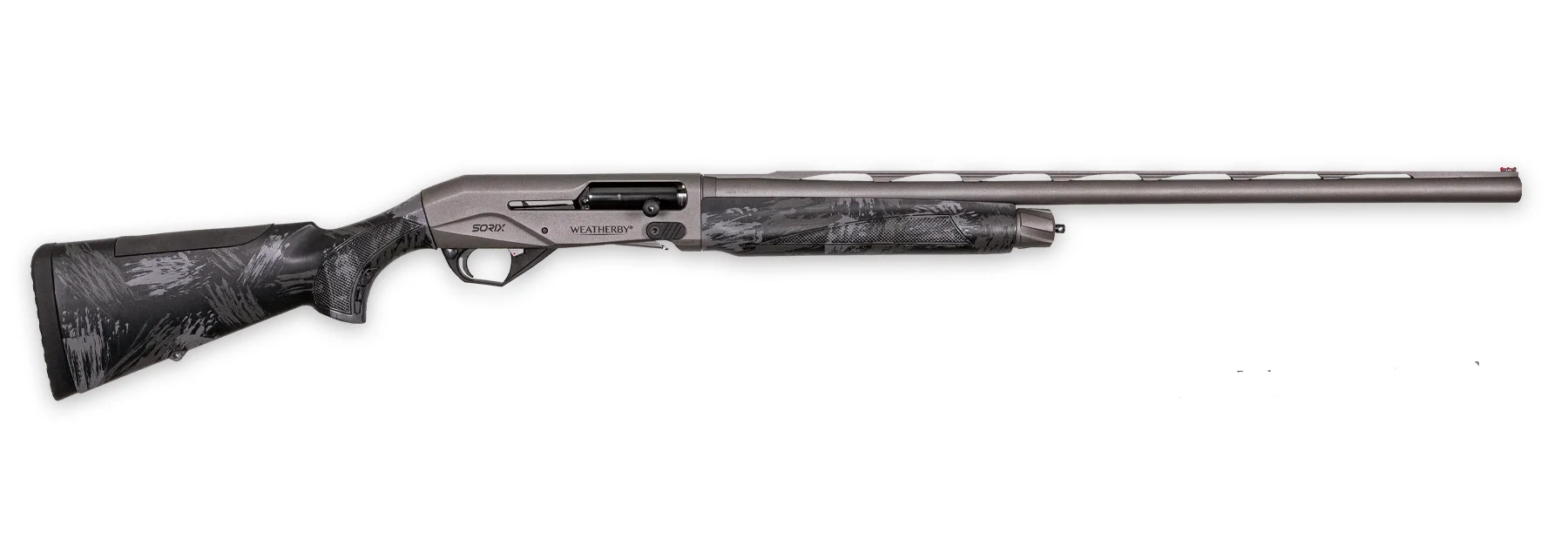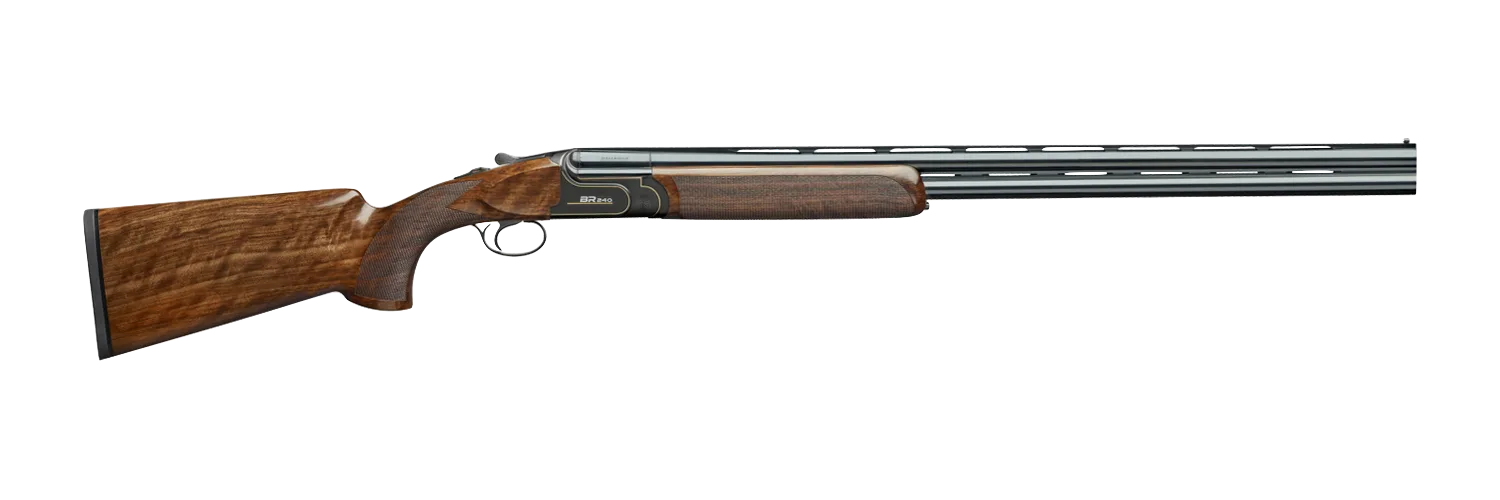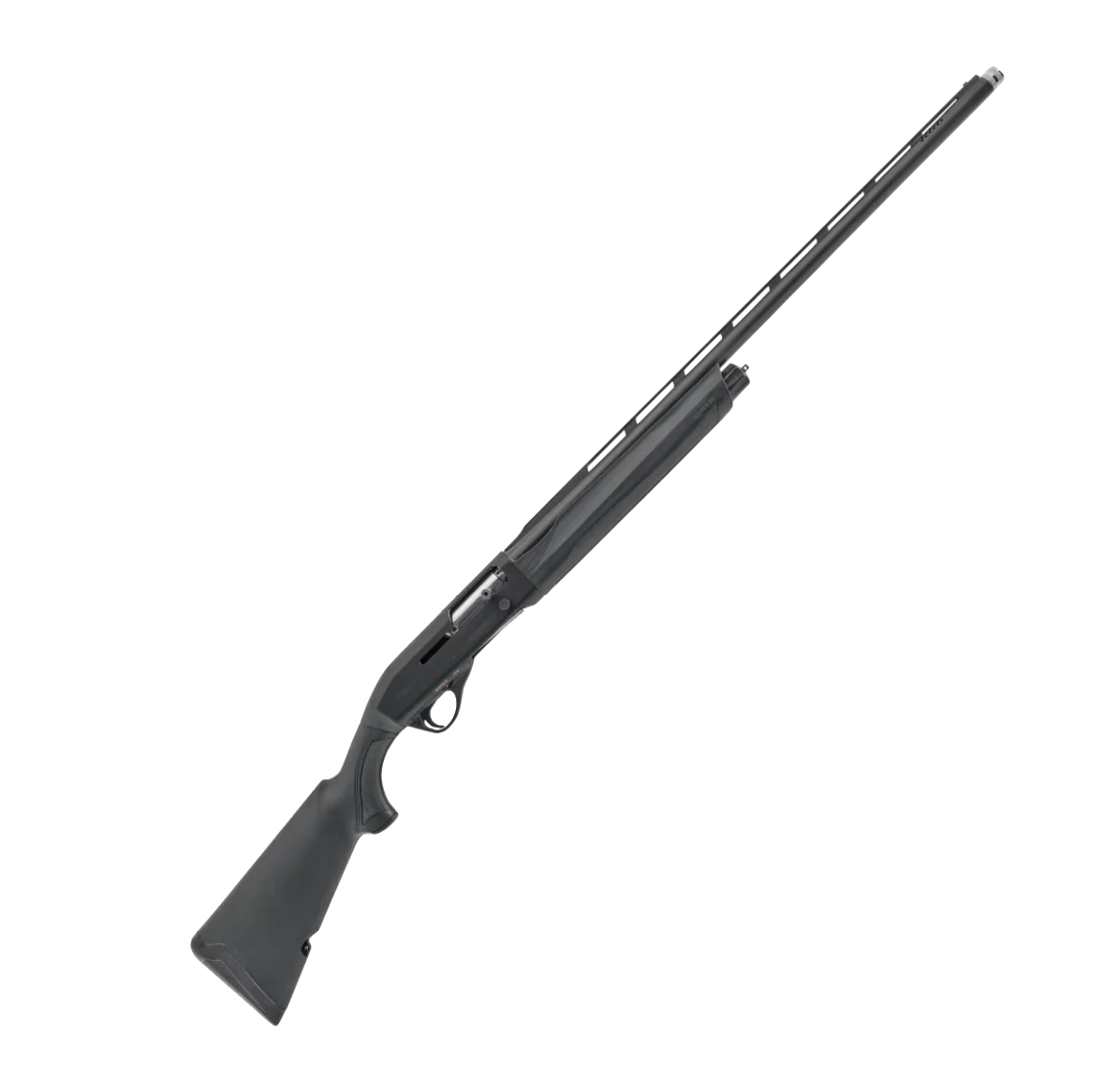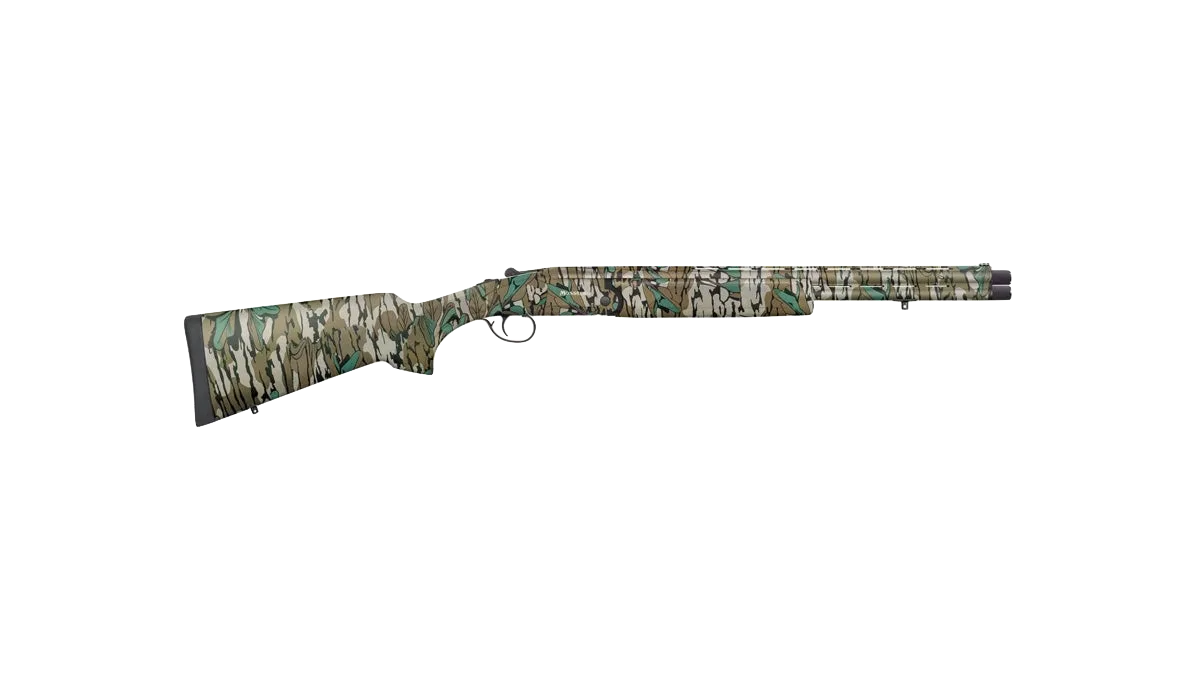We may earn revenue from the products available on this page and participate in affiliate programs. Learn more ›
The 3-inch 28-gauge stole the new-shotgun show last year. For 2024, there is no “it” gun, but that’s probably a good thing for most people looking to buy a new shotgun. We had a bit of everything submitted for our annual test this year, which ups the odds that one (or more) of the guns below will fill the empty space in your safe.
Pressed to name a trend, I’d say that inertia guns are still having their moment. But overall, this year’s crop of new shotguns offers a good mix of styles, as well as some genuine innovations. There is something for everyone, from target shooters to turkey hunters to uplanders and waterfowlers. We did things a little differently this year. Instead of testing all the guns at once over the course of a week or so, I tested them little by little over the course of more than six months, which allowed me to take a closer and more thorough look at each—all the better for making my picks for the best shotguns of 2024. Here they are.
Best Hunting Shotgun: Weatherby Sorix
Best Target Shotgun: Blaser F16 Pro Sporting
Best Value: Mossberg Gold Reserve 20-Gauge Sporting
Best Splurge for Hunting: Benelli Performance Shop Ethos Cordoba A.I. BE.S.T.
Best Turkey Gun: Stoeger 3500 Predator/Turkey
Rest of the Best
How We Tested Shotguns


I gave the guns a workout at skeet and 5-stand. I tested with light target loads for reliability and heavy hunting loads to see how hard they kicked. I shot them for point of impact and patterned the turkey guns. When I needed a second opinion, I called in Clint Hartsock, fellow clay and wingshooter and hunting department manager at Fin and Feather in Iowa City. His perspective as both a shotgunner and a retailer provided useful insights.
After thoroughly testing all of the shotguns, and keeping notes along the way, I ultimately scored each on a 100-point scale, based on the following categories and point values:
Workmanship and Aesthetics: Fit and finish inside and out matter, both for function and for appearance. (Worth up to 20 points)
Reliability: A shotgun has to be reliable. Since there’s only so much I can learn without spending a whole season with a gun, this category only counts for up to 10 points.
Handling and Recoil: Shotguns are instinctively dynamic. How they carry, point, swing, and kick matters as much or more than anything else. (20 points)
Ergonomics: Controls that are hard to find or stiff can cost you chances in the field, and they can make shooting a less pleasant experience. (10 points)
Meets Intended Purpose: Some guns are all-purpose, some are specialized. Whatever the case, a shotgun that doesn’t do what you need it to do isn’t worth owning. (10 points)
Innovation: It’s hard to come up with truly new ideas in shotgun design. This category celebrates real innovation, while recognizing that innovation is rare. (10 points)
Value: It’s your money. You want to spend it, not waste it. Getting a sound return for your dollars is important. (20 points)
Best Hunting Shotgun: Weatherby Sorix
Score: 73
Why It Made the Cut: This new left-hander-friendly inertia gun is well-made, optimized for the duck and goose blind, and has a price tag that’s competitive with Browning and Benelli inertia guns. For that, the Sorix wins Best Hunting Shotgun for 2024.
Specs
Length: 49.75 inches (with 28-inch barrels)
Weight: 7 pounds in 12-gauge with 28-inch barrels
Barrel: 28-inch vent rib, five choke tubes (Crio pattern), small fiber-optic stepped rib
Action: Inertia semiauto
Trigger: 7 pounds, 2 ounces
Capacity: 4+1
Finish: Cerakote metal, choice of three color schemes
Stock: Synthetic, also in three different paint colors
Chambering: 3 ½-inch 12-gauge, 3-inch 12-gauge (tested), 3-inch 20-gauge
Price: $1,499

Pros
Well fit and finished
Good weight and balance
Soft recoil pad
Easy loading
Cons
Reversible charging handle doesn’t win over this lefty
Weatherby has added a brand-new inertia gun to its lineup for 2024. The Sorix has a unique camo/Cerakote finish and robust controls that scream “waterfowl gun.” Made in Italy by C.D. Europe (formerly Marocchi), a long-established gunmaker, it has an easily-switched safety and a unique reversible bolt handle intended to make the gun friendlier to left-handed shooters.
With all the clean-running advantages inertia operation brings to semiauto actions, the Sorix comes in 3- and 3 ½-inch 12-gauge versions, as well as in 3-inch 20-gauge, all with 28-inch barrels. It has super-sized controls and a loading port milled out for fast, easy reloads. Combined with a softer spring and shell latch, as well as a lifter designed not to catch fingers, it loads very easily. I tried loading the gun with bare hands, thin shooting gloves, and bulky insulated gloves, and the lifter never once caused a snag.
The slightly bulged forend and stepped rib call the Benelli M2 to mind, but the gun has a receiver profile all its own. In my testing, I found the Sorix easy to shoot well both in 12-gauge and in 20. The point of impact was close to dead on for me, about a 65/35 pattern, at most. The gun is also drilled and tapped for optics in case you want to take it turkey hunting.
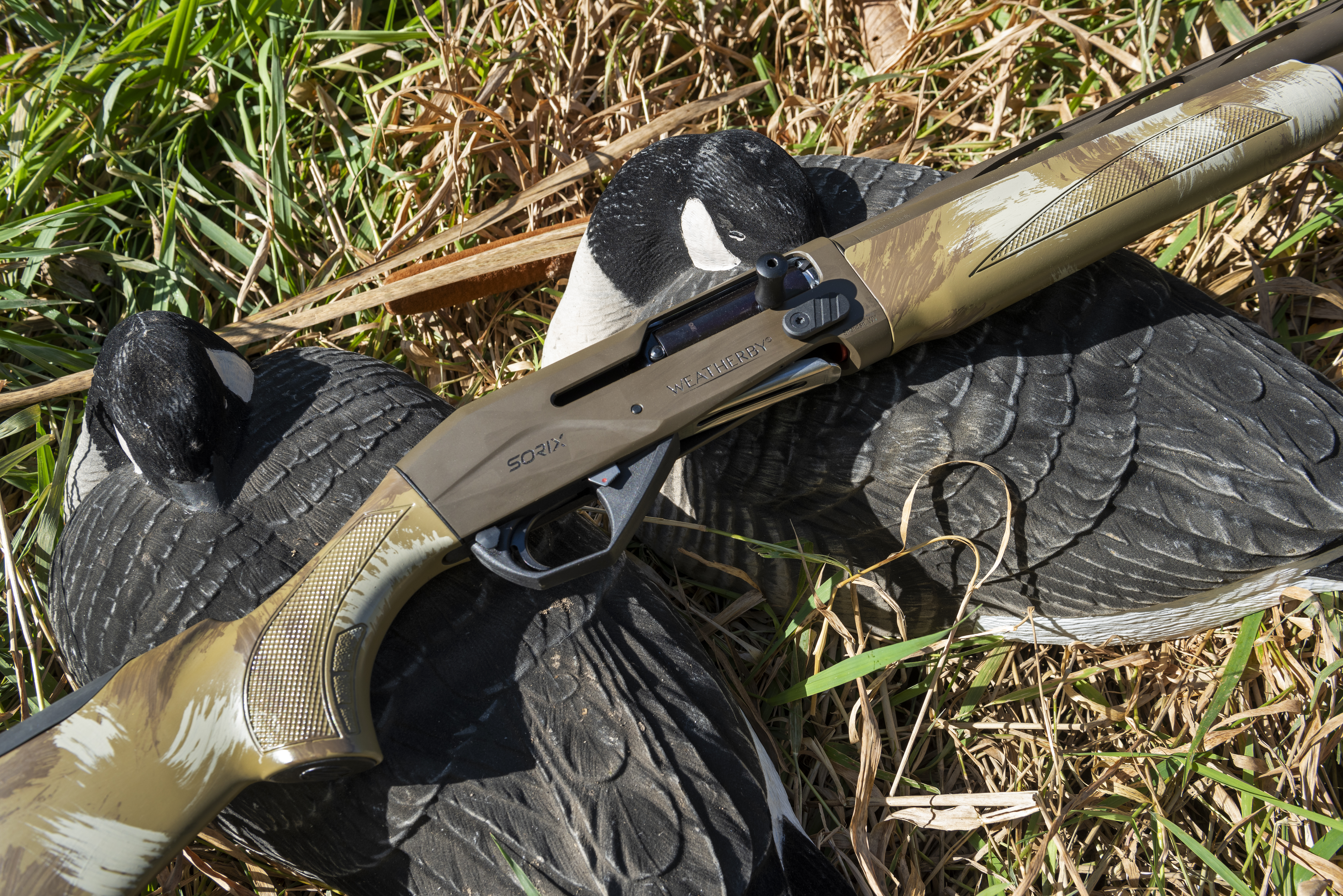
About the reversible charging handle: Weatherby, I’ve heard, found that lefties didn’t like looking at the charging handle flying back toward them in their line of vision when they fired the gun. I have never, in an adult lifetime of shooting right-handed semiautos, noticed a bolt handle coming at me. If I shot a Sorix—and I would—I’d leave the handle on the right side. But maybe that’s just me. Either way, it’s good to have the option. I would reverse the safety, which is easy to do, as it should be, but is not on all guns with crossbolt buttons.
At $1,499, the Sorix is priced a bit below comparable inertia guns, and its score in the value category of this test went a long way toward putting it at the top of our list. If I were in the market for a new duck gun at a fair price, I’d give it strong consideration.
Related: You can read a full review of the Weatherby Sorix here.
Best Target Gun: Blaser F16 Pro Sporting
Score: 90
Why It Made the Cut: With near-perfect scores in most categories, this high-end, soft-shooting target shotgun is loaded with extras at no extra cost. No, it isn’t cheap. But it is a lot of gun for the money.
Specs
Length: 49.5 inches (with 32-inch barrels)
Weight: 8.5 pounds in 12-gauge with 32-inch barrels
Barrel: 30- or 32-inch (tested) vent rib, Rhino ports, two Rhino chokes, small fiber-optic
Action: Break action O/U
Trigger: 5 pounds
Capacity: 2
Finish: Metallic gray
Stock: Gloss-finished grade 4 walnut, Kick-Eez pad, adjustable comb
Chambering: 3-inch 12-gauge
Price: $6,675
Pros
Low recoil
Good balance
Extra features for the money
Cons
Ports and ported tubes require a little extra cleaning
Even at $6,600, the Blaser F16 Pro Sporter is a solid value, with several extras added to the basic F16 Sporter mostly intended to reduce recoil without raising the price. It also happens to be one very fine shotgun.
The basic F16 comes in both Sporter and Field models with a sleek, low-profile action that helps make it a natural pointer. I also happen to think it’s good-looking, in a stripped-down way. The receiver is unadorned while the wood is very well figured, as you’d expect from the Grade 4 walnut that’s standard on the F16. It comes with 30- or 32-inch barrels, and the metal is finished in a muted-metallic gray.
The new Pro model adds a soft Kick-Eez recoil pad, and the pitch (angle of the butt) is recut from the standard 2 degrees to 0 degrees. It seems like a small change, but that altered pitch helps the gun fit better into your shoulder pocket if you lean forward slightly, as most clay competitors do, spreading the recoil over a larger area so it’s less painful.

The Pro also has an adjustable comb with excellent hardware, and it comes with three handled Allen wrenches for making those adjustments. Weights in the stock and beneath the forend, lengthened forcing cones, and Rhino ports all help reduce muzzle jump. Although the gun is heavy gun at 8 ½-pounds, the added weight makes it balance on the hingepin, so it feels lighter than it is, yet still has enough heft to soak up recoil.
Even with heavy target loads, the gun was very pleasant to shoot. It has a nice heft yet is still responsive, soft-shooting, and fast to get back on target. The F16 Pro comes with only two Rhino chokes, a .007 and .017, which are more or less an open Improved Cylinder/Light Modified combination. That’s a good pairing for most courses, and rather than include chokes you might not want, Blaser leaves it at two with the option to buy more if you want. I am not a choke-changer, and I’d stick with these, which performed very well.
Related: Read a full review of the Blaser F16 Pro here.
Best Value: Mossberg Gold Reserve
Score: 72
Why It Made the Cut: Color me surprised by the fit and finish of this very affordable gun, and you get extended tubes and a decent hard case, too. You can nitpick the weight or the trigger pull, but you can’t beat the features you’re getting for the money.
Specs
Length: 47 inches (with 30-inch barrels)
Weight: 6 pounds (20-gauge with 30-inch barrels)
Barrel: 30-inch vent rib, ventilated mid-rib, brass bead, 5 extended chokes
Action: Break-action O/U
Trigger: 8.5 pounds
Capacity: 2
Finish: Engraved silver receiver
Stock: Grade A walnut
Chambering: 3-inch 12-gauge, 3-inch 20-gauge (tested), 3-inch .410
Price: $1,135
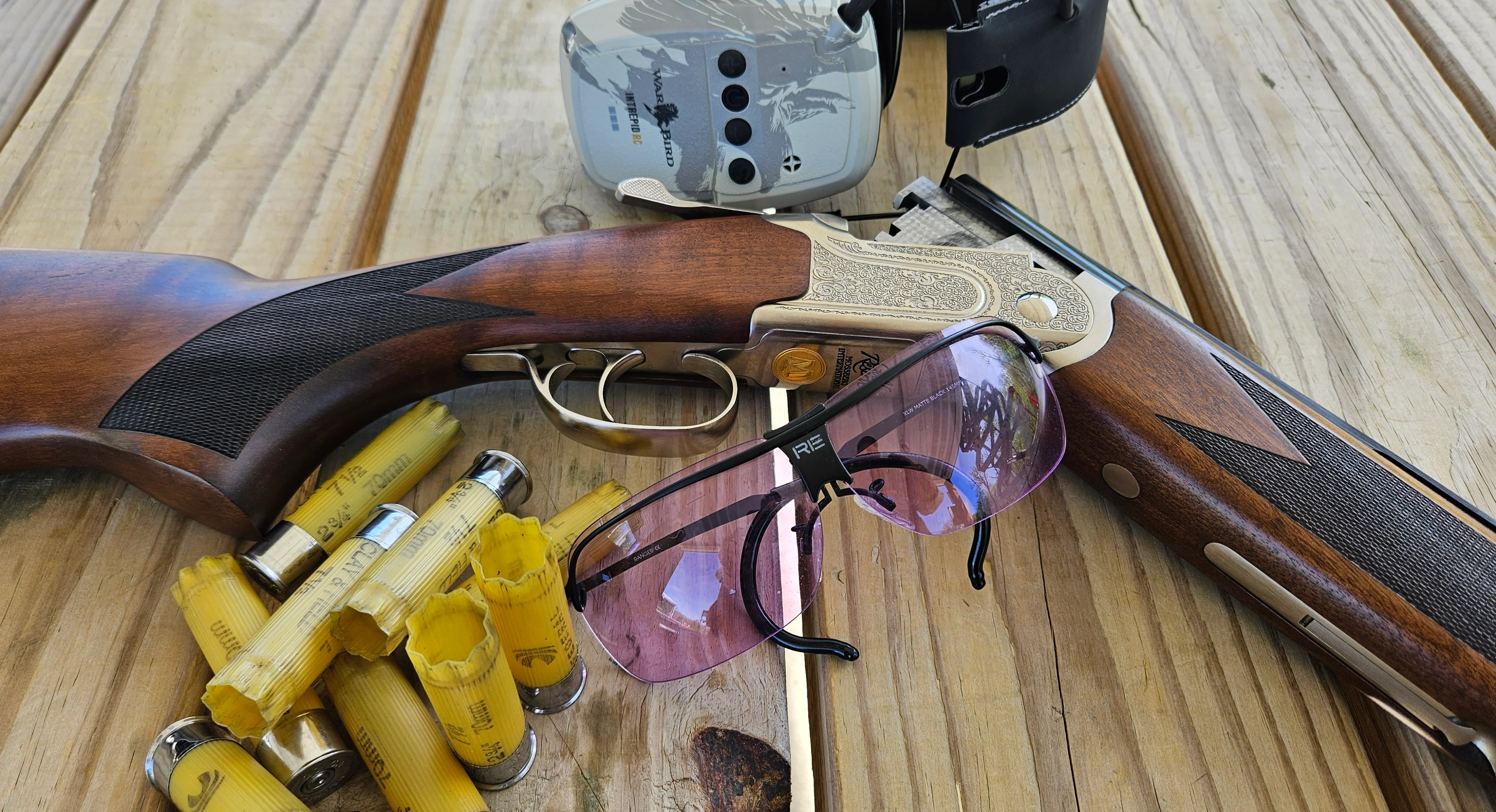
Pros
Good fit and finish
Light and trim
Handles well for upland hunting
Cons
Too light for target shooting
Heavy trigger
The Gold Reserve has dashed my expectations about Mossberg O/Us. There’s nothing clunky nor overweight about the 20-gauge model I tested. In fact, it could stand to put on a few ounces, but we’ll get to that in a minute.
Along with a hard case, the gun comes with five extended choke tubes. Overall, the fit, finish, and decoration are very good for an O/U at this price. The walnut stock on my test gun had some figure to it and a classy satin finish. The buttpad is very thin and doesn’t provide much in the way of recoil mitigation, but it does have a hard-plastic insert up top to help the gun shoulder without snagging. Break the Gold Reserve open, and you’re pleasantly surprised to find that the monoblock of the barrels is jeweled, adding a bit more elegance to the gun’s overall looks. The barrels have a flat vent rib, vented mid-ribs, and a small, simple gold bead.
My 20-gauge test gun weighed exactly 6 pounds. Its 30-inch barrels caused it to balance well ahead of the action’s hinge, but it didn’t feel in the least bit muzzle-heavy to me. Although the gun fit me well and shot flat, 50/50 patterns to my point of aim, I didn’t shoot it particularly well at low-gun skeet. As well-balanced as I think this gun is, it didn’t weigh enough for me to move it as smoothly as I’d like. A 6-pound target gun is tough to shoot at clays. Mossberg lists the gun at 7 pounds, so maybe mine was unusually light.
I did have a couple of quibbles with the controls. The trigger breaks at well over 8 pounds. Also, it’s possible to leave the safety-mounted barrel selector tab between barrels, at which point, it blocks the safety. This isn’t a problem on the clays course, but it could cost you a bird to two in the field. The ejectors worked perfectly.
While the 20-gauge Gold Reserve wasn’t the sporting gun for me, I couldn’t help thinking about what a terrific hunting gun it would make. A 6-pound, 30-inch 20-gauge is not an easy gun to come by at any price point, much less at just over $1,100. Hunting seasons were closed when I tested this gun, and while I always wish it were hunting season, having the lithe 20-gauge Gold Reserve in hand made me wish it even harder.
Best Splurge for Hunting: Benelli Performance Shop Ethos Cordoba A.I. BE.S.T.
Score: 72
Why It Made the Cut: Full of Benelli’s tech advancements, like the BE S.T. finish and the Easy Locking Bolt for ultimate reliability, the Ethos Cordoba is weatherproof, dependable, and it squeezes a little extra out of every payload it sends downrange.
Specs
Length: 49.5 inches (with 28-inch barrel)
Weight: 6.9 pounds
Barrel: 28-inch vent rib, ventilated mid-rib, brass bead, 5 extended chokes
Action: Inertia semiauto
Trigger: 7 pounds, 2 ounces
Capacity: 4+1
Finish: Matte black BE S.T.
Stock: Black synthetic with ComforTech stock
Chamberi
ng: 3-inch 12-gauge
Price: $3,649

Pros
BE S.T. finish protects metal corrosion and abrasion
Good weight and balance
Advanced Impact appears to work
Cons
Expensive
Loading is stiff
What sets the latest offering from the Benelli Performance Shop apart is that it incorporates “A.I.” But in this case, those letters stand for the company’s new “Advanced Impact” boring system. Intended to wring more velocity and energy out of shot patterns, this feature combines with others, like the ComforTech stock and BE S.T. finish, to make this the highest-tech Benelli yet. Despite its considerable price tag, it’s a gun meant for rough use in rugged conditions.
The gun has a matte-finished barrel with carbon-fiber rib, an alloy receiver, and black, synthetic furniture with molded dimpling in place of checkering. Metal parts have Benelli’s BE S.T. (Benelli Surface Treatment), which protects against salt very effectively. It has a 3-inch chamber, Benelli’s ComforTech stock, barrel porting, and a weighted magazine cap to reduce recoil. The Ethos Cordoba also has the large bolt handle and closer-button that waterfowl hunters have come to expect on their shotguns, though it does lack the relaxed spring and mag latch of some other Benellis that make them easier to load.

This is one of the first Benelli shotguns to incorporate their new Advanced Impact barrel and choke system, which the company claims produces higher velocities and a shorter, denser shot string, resulting in greater energy downrange. The idea here is that the redesigned, tapered bore creates a Venturi effect that accelerates shot slightly. I chronographed shots from the A.I. barrel and an M2, which has the same length barrel. Two different target loads both showed a consistent, modest (25 fps) edge in velocity for the A.I. barrel over the M2 barrel at 5 feet from the muzzle. A penetration test at 30 yards with bismuth shells showed pellets from the Ethos Cordoba averaged deeper penetration than the M2, perhaps because the A.I. barrel profile led to fewer deformed bismuth pellets. In the end, my testing seems to confirm that Benelli’s A.I. tech works and may indeed give you a slight ballistic edge. That said, it doesn’t make your other guns obsolete.
On the range, the gun shot high for me initially, but after I altered the fit with the included shims and brought the pattern down to a more field-ready 65/35, it was right on. At a hair under 7 pounds, with the included magazine-cap weight—which for some reason is a chore to screw on—the gun balanced well.
The Ethos Cordoba AI BE S.T. is a shooter and would make a fine all-around hunting/target gun, although ported guns aren’t welcome in every duck blind. It’s not a cheap gun in the least, but if you want every last technological advantage regardless of cost, the Performance Shop Cordoba Ethos AI BE S.T. is the new shotgun for you.
Best Turkey Gun: Stoeger 3500 Predator/Turkey
Score: 67
Why It Made the Cut: It’s heavy, bulky, kicks some, but all that comes second to how well it shoots big and small shot. This gun delivers great patterns, and that is its primary reason for being. For that simple reason, it wins the Best Turkey Gun award.
Specs
Length: 46 inches
Weight: 7.5 pounds
Barrel: 24-inch vent rib, fiber-optic bead, ported, one Full one XX-Full choke
Action: Inertia semiauto
Trigger: 7.5 pounds
Capacity: 4+1
Finish: Mossy Oak Overwatch
Stock: Synthetic
Chambering: 3 ½-inch 12-gauge
Price: $929

Pros
Ergonomic grip
Great patterns
Stock shims
Drilled/tapped receiver
Cons
Stout recoil
Mediocre trigger
Stoeger’s new 3 ½-inch 12-gauge 3500 Predator/Turkey is meant to be a two-season gun, ready for spring gobblers and winter coyotes. It comes with two Mojo chokes, an XX-Full and an extended Full. It has an enlarged bolt handle, a slammer button, and a nice, big triangular safety. It is dipped in Mossy Oak Overwatch camo and comes with a black paracord sling.
The 3500 has enough heft at 7 ½-pounds that it’s easy to hold on target, and the SteadyGrip is a very comfortable, sensible handle for a shotgun intended to be aimed. Despite what I considered an overly large orange bead sight, I was able to put the gun’s patterns right where I wanted to. I did pay a hefty price in recoil. Like many inertia guns, this one kicks with heavy loads. The trigger has some creep and some squish, and it breaks at around 7 pounds, which isn’t great.
But the gun shot excellent patterns. With the Full choke in place, it consistently put 8 of 12 Federal Premium 00 buck pellets in a 10-inch circle at 40 yards. The only other predator load I had on hand was Federal’s old 15gr/cc tungsten-iron Heavyweight BBs which, fortunately for coyotes, is no longer made. Those averaged 26 (out of 66 total in the load) in the 10-inch circle.
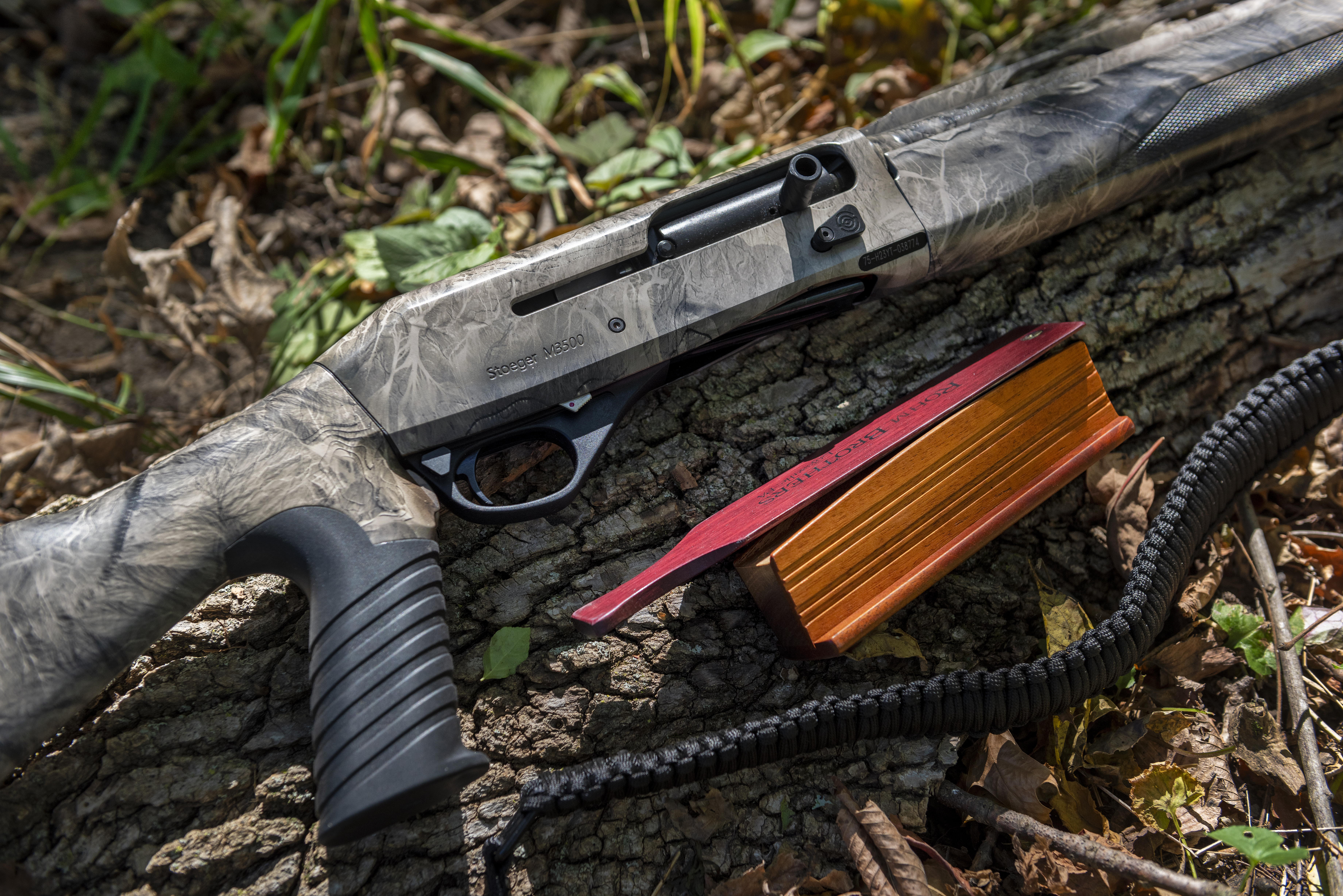
With the turkey choke, I got patterns well in excess of 300 holes in a 10-inch circle with 2-ounce loads of Hevi18 TSS 9s at 40 yards. With 3-inch, 1 ¾-ounce Winchester lead LongBeard 4s, the turkey choke averaged a very good 127 hits in the 10-inch circle. Back in the days before TSS spoiled us, 127 4s in a 10-inch circle at 40 yards was exciting.
The milled-out loading port and a softer magazine spring and carrier latch made the gun easy to load quickly. The 3500 cycled heavy hunting loads fine but balked at running target loads. The gun might break in, it might not, but shooting 1 1/8-ounce loads of bird shot isn’t part of this gun’s job description anyway. It’s a big gun, meant for shooting big birds, as well as coyotes, and for that special purpose, it’s the hammer you want for the job.
Related: You can read a full review of the Stoeger 3500 Predator/Turkey here.
Rizzini BR 240 Cole Special Sporting
Score: 81
Why It Made the Cut: Rizzini guns fly under too many people’s radars, and this collaboration with Cole should raise their profile. It’s a well-made, good-looking, shootable target gun. A stock tweaked for American shooters should also help this gun find a bigger following here.
Specs
Length: 50.5 inches with choke tubes installed
Weight: 8.2 pounds
Barrel: 30 or32 inches (tested) plus extended Cole chokes, flat vent rib, ventilated mid-rib, middle bead, white Bradley front bead, blued
Action: Break-action O/U
Trigger: 3 pounds, 10 ounces, adjusts for length
Capacity: 2
Finish: Black Cerakote with gold on receiver
Stock: Oil finished walnut, adjustable comb, right-hand palm swell
Chambering: 3-inch 12-gauge
Price: $5,400
Pros
Excellent trigger
Good weight and balance for sporting gun
Nice lines and finish
Cons:
Must remove chokes to fit into hard case
Thin, ineffective recoil pad
The Rizzini BR240 Cole Special Sporting is a run of Rizzini’s target O/Us built with specs to suit American shooters in partnership with Cole Fine Guns and Gunsmithing, a well-known name in target shooting circles. The Cole Special has a trigger that adjusts for length to accommodate different-size hands, a more pronounced right-hand palm swell and a more tightly curved pistol grip, along with a slightly longer length of pull.
It’s good-looking, too, with classic target gun lines (full pistol grip, round-tipped forend). The wood is a fairly straight-grain, oil-finished walnut, and the receiver is finished in matte dark-gray Cerakote with gold accents. The gun’s design is the ubiquitous and time-tested “Brescia O/U” design seen in Caesar Guerinis, Fabarms, Faustis, and others, with barrels pivoting on trunnions and an underbite lockup. It comes with five extended, silver Cole choke tubes and a hard case.

My test gun balanced just ahead of the trunnions. It had enough weight up front to be mannerly and easy to swing without being too muzzle-heavy. At 8 pounds, 3 ounces overall, it absorbed recoil even from heavy 3-dram, 1 1/8 ounce loads, despite its inadequate recoil pad. The trigger broke at a consistent, clean, 3 pounds, 10 ounces. As for the Cole extended tubes, there were some targets that turned inside out when I hit them, and while I’d like to take the credit, I’m not sure it was all me.
The gun isn’t perfect. The butt pad is thin, solid rubber. Although it didn’t kick badly, a gun like this still deserves a thick, soft pad. Also, the Rizzini case isn’t long enough to accommodate 32-inch barrels with choke tubes installed. You have to take the chokes out every time you want to put the gun back in its hard case. I am assured that in the future, these guns will come in longer cases that will let you leave the chokes installed.
The BR240 Cole Special Sporting is a gun intended for the serious recreational shooter who maybe enters two or three tournaments a year, and likes seeing Xs on the scorecard. If that’s you, then you’ll want to take a close look at this one.
Fabarm L4S Allsport
Score: 78
Why It Made the Cut: Shooters looking for one gun for all target disciplines will find plenty to like in the L4S’s quick-change rib, adjustable comb, and soft-recoiling gas operation.
Specs
Weight: 8 pounds
Barrel: 30-inches with interchangeable vent rib, white bead, five choke tubes
Action: Gas semiauto
Trigger: 7 pounds
Capacity: 4
Finish: Blued steel, black anodized alloy with enamel highlights
Stock: Oil-finished walnut
Chambering: 2 ¾-inch 12-gauge
Price: $2,750 ($2,950 for LH)
Pros
All-discipline versatility with interchangeable ribs
Soft recoil
Excellent fit and finish
Sturdy hard case
Cons
Not suitable for low-gun shooting
The Fabarm L4S Allsport is a jack-of-all-trades target gun, made to shoot every target discipline. The quick-change rib, adjustable comb, and excellent choke tubes allow you to switch it from sporting gun to trap gun in a couple of minutes—which saves you from having to buy another shotgun.
The Italian-made Fabarm L4S is a very good gas gun that hasn’t quite yet received its due in the U.S. It is reliable and soft-kicking. The gas system parts are beautifully polished and shiny, and the gun has its action spring around the magazine tube where it’s easy to see and clean.
The barrel, like all Fabarm barrels, is both proof-tested to a higher-than-usual level (1630 BAR) and deep-drilled to Fabarm’s Tribore dimensions. Each Tribore barrel has a long forcing cone taper, an over-bored section, then a long taper to the choke section, which does produce small increases in velocity. Fabarm’s focus on barrel making is also reflected in the fact that they make their own choke tubes, a part many gunmakers outsource.

The gun comes with two ribs, one set up to deliver a 50/50 point of impact for skeet and sporting clays, the other a 65/35 rib that gives you the elevated POI that works best for trap. Swapping out the ribs takes less than a minute. If you want to alter the stock dimensions when you switch disciplines, the Micro Metric 3D adjustable comb takes a little longer to change with an Allen wrench than the rib, but not much longer.
My test gun has a 30-inch barrel and weighed exactly 8 pounds on my scale. On the range, I thought it moved well to the target, and recoil was negligible. It is a very pleasant gun to shoot. It is, however, stocked with the assumption that you’ll be shooting it pre-mounted. I found it very difficult to shoot from any kind of low gun start. Shooting it gun-up, however, was a breeze.
The trigger breaks at 7 pounds. The weight didn’t bother me at all, especially because the pull was crisp and clean, but it might annoy the easily annoyed. In the end, the L4S is good-looking, soft-shooting, versatile—and a good choice if you want one target gun for every discipline.
Mossberg 940 Pro Waterfowl
Score: 69
Why It Made the Cut: Better waterproofing and an improved safety button make this gun the best Mossberg semiauto yet. The red-dot slide cut belongs on turkey guns, not duck guns, though.
Specs
Length: 49.75 inches (with 28-inch barrels and stock spacers in place)
Weight: 7.7 pounds
Barrel: 28-inch vent rib, two flush mount, one extended Accu-Choke (Winchoke pattern), seven interchangeable fiber-optic beads
Action: Gas semiautomatic
Trigger: 5 pounds, 5 ounces
Capacity: 4+1
Finish: Patriot Brown Cerakote
Stock: Synthetic, Mossy Oak Shadowgrass camo
Chambering: 3-inch 12-gauge
Price: $1,264
Pros
Coated internal parts for better function
Improved new top safety design
Wide range of stock adjustment
Cons:
I’m not sold on the red-dot cut
Nose-heavy balance
For 2024, Mossberg is offering a new version of the 940 Pro Waterfowl, which adds two new features to the already long list of improvements made to this gun over time. One of the improvements is very welcome; the other, I’m not sure about.
All 940 Pros feature buffer tubes upgraded from plastic to ported aluminum, a stainless-steel return spring, boron and chrome-lined chambers and bores. It has a self-draining stock, which helps prevent corrosion damage to the return spring and tube. Mossberg claims the 940 Pro will run 1500 rounds between cleanings.
The upgraded Waterfowl version comes in 3-inch, 12-gauge, with a 28-inch flat-rib barrel and a Hi-Viz fiber-optic bead with seven interchangeable bead options. One extended, Modified Accu-Choke and two flush choke tubes are included. Metal parts have exterior “Patriot Brown” Cerakoting. The synthetic furniture is dipped in original Mossy Oak Shadowgrass camo, and the black butt pad has several spacers that allow you to adjust the length of pull from 13 inches to 14.25 and make drop and cast adjustments. It has a huge charging handle and bolt-release button, and a brand-new, enlarged safety, which marks a much-needed improvement over Mossberg’s old top safeties. This one, while still plastic, is broad, textured, and easy to use.
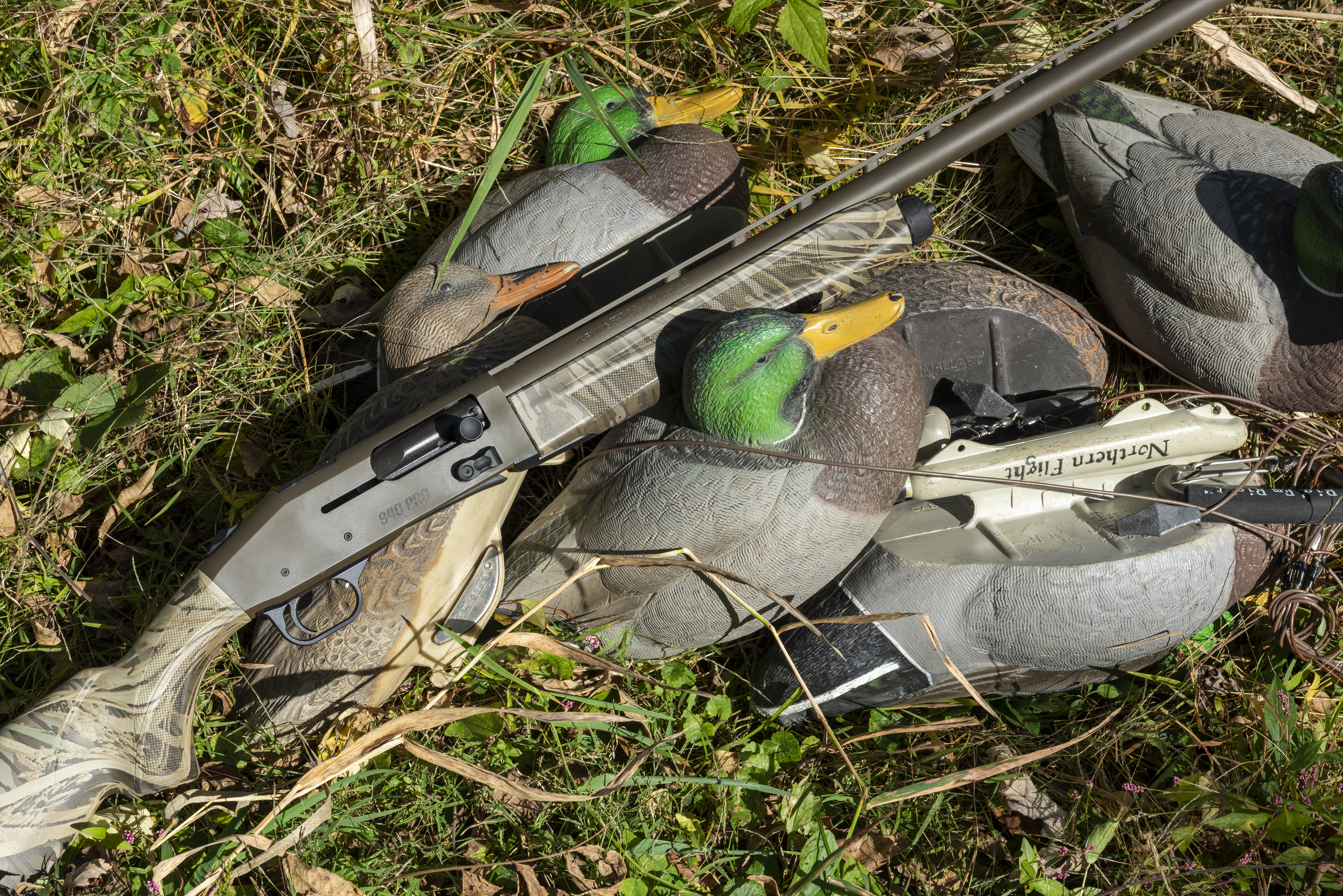
My test gun weighed 7.7 pounds, with a lot of that weight in the front end. It feels nose-heavy and awkward when you pick it up, but it swings smoothly, even inevitably, to the target. The trigger broke a little above 5 pounds. It did not like the Browning 1200 fps, 1 1/8 ounce target I fed it, as the hulls would stick in the chamber or not fully eject. However, lighter 1180 fps, 1-ounce loads worked fine, as did every other target and hunting load I tried in it.
The most apparent addition to the 940 Pro Waterfowl is the receiver cut for an RMSc Shield-pattern red dot. I tried shooting with one and found that the red-dot detracted from my ability to hit because it added the frame of the dot as an obstacle to seeing the target. I’d use the included filler plate and shoot this weatherproof waterfowl gun the old-fashioned way.
Franchi Affinity 3 Sport-Trap
Score: 66
Why It Made the Cut: The new Sport-Trap is an admirable attempt to make one gun for everything, although like every compromise, it has its drawbacks.
Specs
Length: 52 inches including extended choke
Weight: 7 pounds
Barrel: 30-inch stepped rib, small fiber-optic bead, 3 extended chokes
Action: Inertia semiauto
Trigger: 5.5 pounds
Capacity: 4+1
Finish: matte metal
Stock: black synthetic
Chambering: 3-inch 12-gauge
Price: $999
Pros
Good balance for trap and waterfowl/doves
Enlarged controls
Good trigger
Cons
Stiff shell latch
Light for targets (but a good weight for hunting)
Franchi’s Affinity 3 Sport-Trap is the latest in a commendable trend toward “crossover” guns made for hunting and clay shooting. It combines both range and field features into one 12-gauge semiauto that you can take from the trap field to the duck blind.
The Sport-Trap has several features people like in a hunting gun, including a 3-inch chamber, a synthetic stock, and swivel studs. It also has a 30-inch ported barrel with a stepped rib, a fiber-optic sight, extended choke tubes, Franchi’s effective TSA recoil pad, and enlarged controls, all of which come in handy both on the range and in the field. The trigger breaks cleanly at 5 ½ pounds, which is a plus for target shooting and works in the field, too.
Everything about my test gun worked properly. The inertia system cycled 1180-fps, 1-ounce target loads fine, and the enlarged bolt handle and closer buttons were easy to use. The shell latch, however, was stiff, which would make loading this gun for trap or skeet doubles or sporting clays a pain, but no problem for trap singles where you load the gun through the ejection port, then push the closer button.

The gun comes with three extended chokes—IC, Modified, and Full—and with stock shims to adjust for drop and cast. TSA pads of varying widths are available as accessories. With the ability to alter measurements and change chokes easily, you can use this gun for a variety of purposes. For instance, you can straighten the stock to achieve a higher point of impact for trap, then drop it down for hunting or sporting clays.
At the same time, the Sport-Trap, like all crossovers, is a compromise. I prefer a heavier gun for target shooting, both for smoothness and for recoil reduction. And I’d prefer an unported barrel for duck hunting, out of concern for my blind-mate’s ears. And while I like hunting with inertia guns, I prefer the recoil reduction of a gas semi-auto. All of that said, the Affinity 3 Sport-Trap represents a good value in a gun that can take you from scholastic or league trap to the duck blind or dove field.
Related: You can read a full review of the Affinity 3 Sport-Trap here.
Tristar Phoenix
Score: 64
Why It Made the Cut: Side-by-side guns must never go away, and it’s always nice to see a new one. The Phoenix is very affordable, and its single trigger and pistol-grip stock give it a familiar feel for those used to other types of shotguns.
Specs
Length: 45 inches
Weight: 6.75 pounds (20-gauge)
Barrel: 28-inch concave rib, brass bead, 5 extended chokes
Action: Break-action side-by-side
Trigger: 7 pounds
Capacity: 2
Finish: Case-colored receiver
Stock: Gloss walnut
Chambering: 3-inch 12-gauge, 3-inch 20-gauge (tested)
Price: $795
Pros
Excellent value
Good wood and finish
Cons
On the heavy side
The new Phoenix from Tristar adds an affordable option to the side-by-side double market. Tristar already had a side-by-side, the Bristol, and the Phoenix is basically a budget Bristol, with extractors in place of ejectors.
Made by Kral in Turkey, the Phoenix is available in 3-inch 12- and 20-gauge models, both of which come with chrome-lined barrels that can withstand steel shot and five Beretta-style flush-mounted choke tubes. Instead of the Bristol’s oil finish, this one has a gloss urethane coat on its forend and pistol-gripped stock. The frame is case-colored. Fit-and-finish-wise, the gun is a mixed bag, but remember, we’re looking at an $800 double gun.
My 20-gauge test gun weighed 6 ¾ pounds with 28-inch barrels, which is a little heavy for an upland 20, but not too heavy. The trigger breaks cleanly at about 7 pounds, which is good compared to many Turkish doubles I’ve shot.

At the range, I found it to be flat-shooting and easy to hit skeet targets with. The stock has a lot of drop to it, giving me a view flat down the barrels. The gun has a traditional concave rib, which is designed not to be seen. If you want a rib to sight down, you won’t find one on this gun. The recoil pad is thin, but fairly soft, and it has a hard-rubber insert on top to keep it from grabbing your clothes as you raise the gun.
The mechanical single trigger always worked, and the extractors lifted fired and unfired shells. The chokes tubes spun in and out smoothly, and the forend latch was easy to use. Only the barrel selector on the safety was a problem on my test gun. It was too easily bumped so that it rested between left and right, resulting in a safety that wouldn’t push forward. If this were my gun, I’d want the selector fixed. That problem aside, the Phoenix is a good gun for the money, especially if you want a side-by-side with a single trigger in place of the traditional double triggers.
Related: You can read a full review of the Tristar Phoenix here.
Mossberg Silver Reserve Eventide Turkey
Score: 58
Why It Made the Cut: How many turkey guns are cute? This one is. It’s also very compact due to the fact that it’s a break-action. It puts plenty of pellets on target, and it comes in all four gauges.
Specs
Length: 37.5 inches
Weight: 6.5 pounds
Barrel: 20-inch vent rib, fiber-optic bead, two X-full turkey chokes, one Improved Cylinder
Action: Break-action O/U
Trigger: Single-selective,7-plus pounds
Capacity: 2
Finish: Mossy Oak Greenleaf
Stock: Synthetic
Chambering: 3-inch 20-gauge, 3-inch 28-gauge (tested), 3-inch .410
Price: $927
Pros
Shoots to point of aim
Compact
Choice of chokes
Cons
Single bead sight only
Heavy trigger
Over-under shotguns are a rare sight in the turkey woods. And Mossberg’s new Silver Reserve Turkey, with its coat of Green Leaf camo and its 20-inch barrels that keep its overall length to a stubby 37 ½ inches, is a gun that won’t be seen so much as heard. O/Us have their advantages for turkeys. One is that two barrels give you a choice of chokes, so you can be ready for the long shots with an XX-Full turkey tube and have an open-choked barrel on call for the birds that sneak in tight. And because the O/U action[PB1] is shorter than the average repeater’s action by 3 or 4 inches, it’s a more compact gun overall, making it easier to tote and handle in the woods.
The Eventide Turkey comes in 3 ½-inch 12-guage and 3-inch 20-, 28-, and .410. I chose the trendy 3-inch 28-gauge to test. It’s cute, it’s tiny, and it’s a simple gun, with a single selective, mechanical trigger and extractors. It has sling-swivel studs on its barrel and synthetic stock and a vent rib with single fiber-optic bead.
Like so many Turkish gun break-actions, it has a rough trigger that’s heavy, creepy, and squishy at 7-plus pounds. That said, when loaded with pure TSS, the Silver Reserve Eventide shot very well. At 40 yards, the Hevi18 1 ¼-ounce loads of 9 TSS averaged 135 hits in a 10-inch circle. The Apex 1 1/2 ounce Greenleaf loads of 9/10 blends scored 160 hits and above, which is very good performance and more than enough for turkeys at 40 yards.
The gun comes with an IC choke, so you can set the two barrles up with one turkey choke and one open. Out of curiosity, I tried it. At 15 yards, as I expected, the turkey choke put almost the entire load of Hevi18 TSS into a 5 or 6-inch circle. The IC choke put 189 pellets into the 10-inch circle, and I estimated its overall lethal spread at 13 inches. That extra 7 or 8 inches of pattern spread up close can make a big difference. If you like the idea of a smallbore O/U in the woods, this is the gun you want.
Why Trust Us
For more than 125 years, Field & Stream has been providing readers with honest and authentic coverage of outdoor gear. Our writers and editors eat, sleep, and breathe the outdoors, and that passion comes through in our product reviews. You can count on F&S to keep you up to date on the best new gear. And when we write about a product—whether it’s a bass lure or a backpack—we cover the good and the bad, so you know exactly what to expect before you decide to make a purchase.


